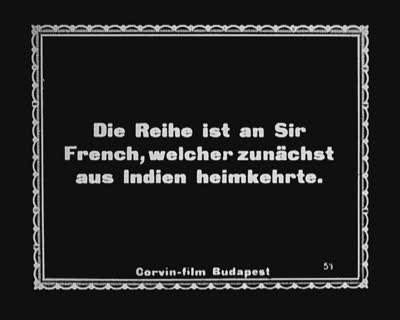|
Farsangi mámor
moving image document > clip
Title
Farsangi mámor (clip)
Description
Video version of the surviving fragment, produced especially for LOST FILMS by the Hungarian National Film Archive and the Deutsche Kinemathek. The basis for the video version was the safety positive print produced from the original nitrate by the Hungarian Film Lab for the Hungarian National Film Archive in Summer 2010. The nitrate was first printed onto colour negative stock to preserve its colour tints. The resulting colour print struck from this negative was first shown publicly at the 29th edition of the prestigious Pordenone Silent Film Festival in Italy on 6th October 2010 (the festival catalogue can currently be accessed as a .PDF on the festival's website here). For presentation purposes, the original "flash titles" were reset and extended to readable length. As there is today no indication surviving as to whether the titles were tinted a specific colour or not, they were left in black and white. For the video version, digital tools were used to correct occasional image unsteadiness caused due to re-printing the fragile and shrunken nitrate material. Care has been taken to correct only serious errors introduced in the re-printing stage and not to anachronistically improve on the limitations inherent to the original production process. No further digital restoration processes, such as scratch or dirt removal, have been applied. The bi-lingual (English/German) text of the new substitute start titles loosely follows the original German censorship card, available to view on this site here. The Hungarian spelling of the actors' and the director's names is respected throughout. The images playout at a speed that would equate to 18 frames per second in projection. The entire video lasts 3 minutes 50 seconds. Click on the "ZOOM" button to play the video. (Note: The fragment had survived combined with shots from another film or films, which to date remain unidentified. These shots were preserved together with the rest of the fragment but have for the purposes of this video presentation been removed. They can, however, be viewed in a separate video here) The film's director Márton Garas was born in Újvidék in the Austro-Hungarian Empire (now Novi Sad in Serbia) in 1885. In 1906, he graduated from the Budapest School for Dramatic Arts and began his career as an actor. In 1911 he went to Berlin, becoming a member of Max Reinhardt’s theatrical company and later performing in the Königlisches Schauspielhaus. He began his film career in 1915 working for Jenő Janovics’ Proja company in the Transylvanian city of Kolozsvár (now Cluj-Napoca in Romania). After directing six films for Janovics, Garas returned to Budapest where he worked for most of the major studios. He made around 39 films in total, including the literary adaptations, Karenina Anna (1918) and Twist Olivér (1919), for which he is best remembered. Unlike many of his contemporaries, Garas stayed in Hungary after the collapse of the first Hungarian Soviet Republic in 1919. He directed his last four Hungarian films for the Corvin company in 1921 and shortly thereafter moved to Germany, where he directed his last film Christoph Columbus (1923). After this he seems to have given up his career in cinema to concentrate on theatre, returning to Hungary in 1924 to become director of the Belvárosi Theatre in Budapest for a while. He died in Budapest in 1930. Gyöngyi Balogh / Oliver Hanley, 06.12.2010
Related collections
Deutsche Kinemathek - Museum für Film und Fernsehen (is a part of) Magyar Nemzeti Filmarchívum / Hungarian National Film Archive (is a part of)
Collection category
film archive
Classification
moving image document > clip |
 |